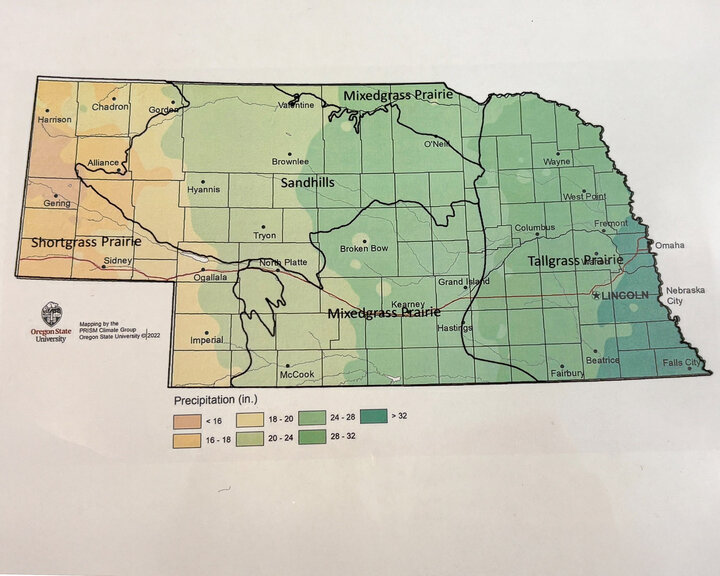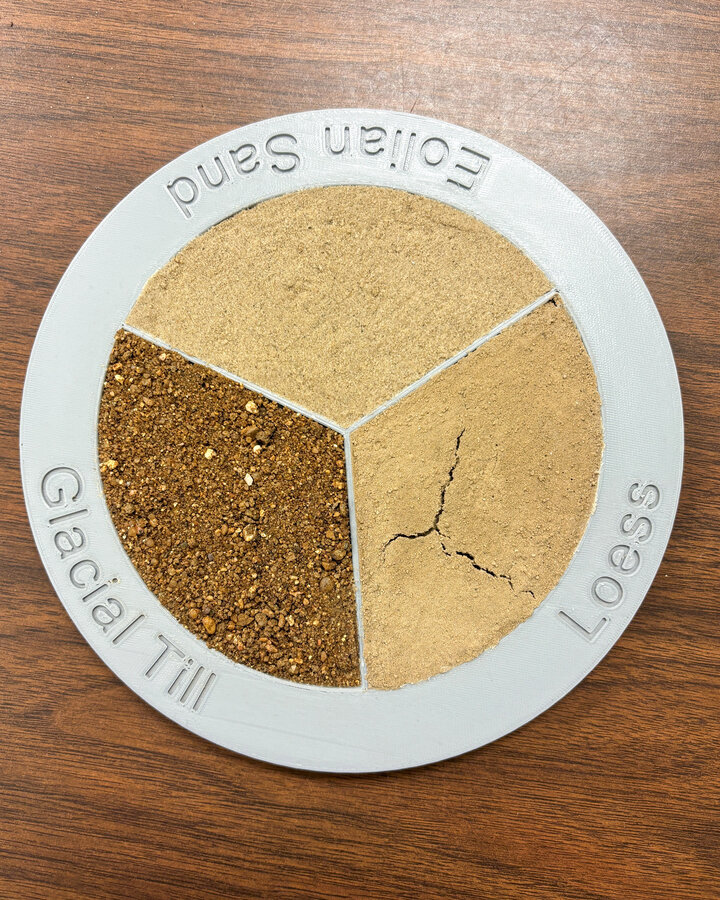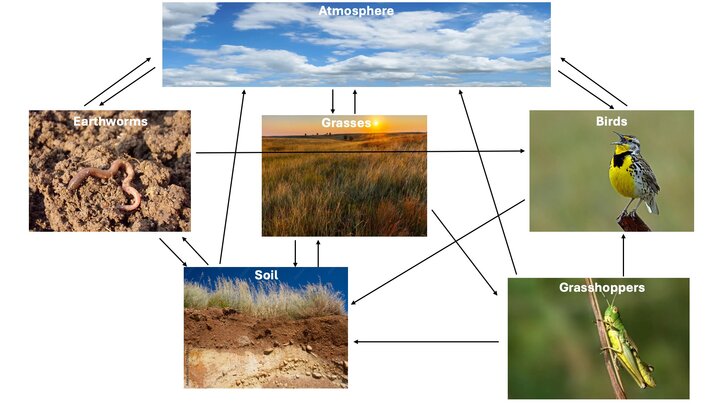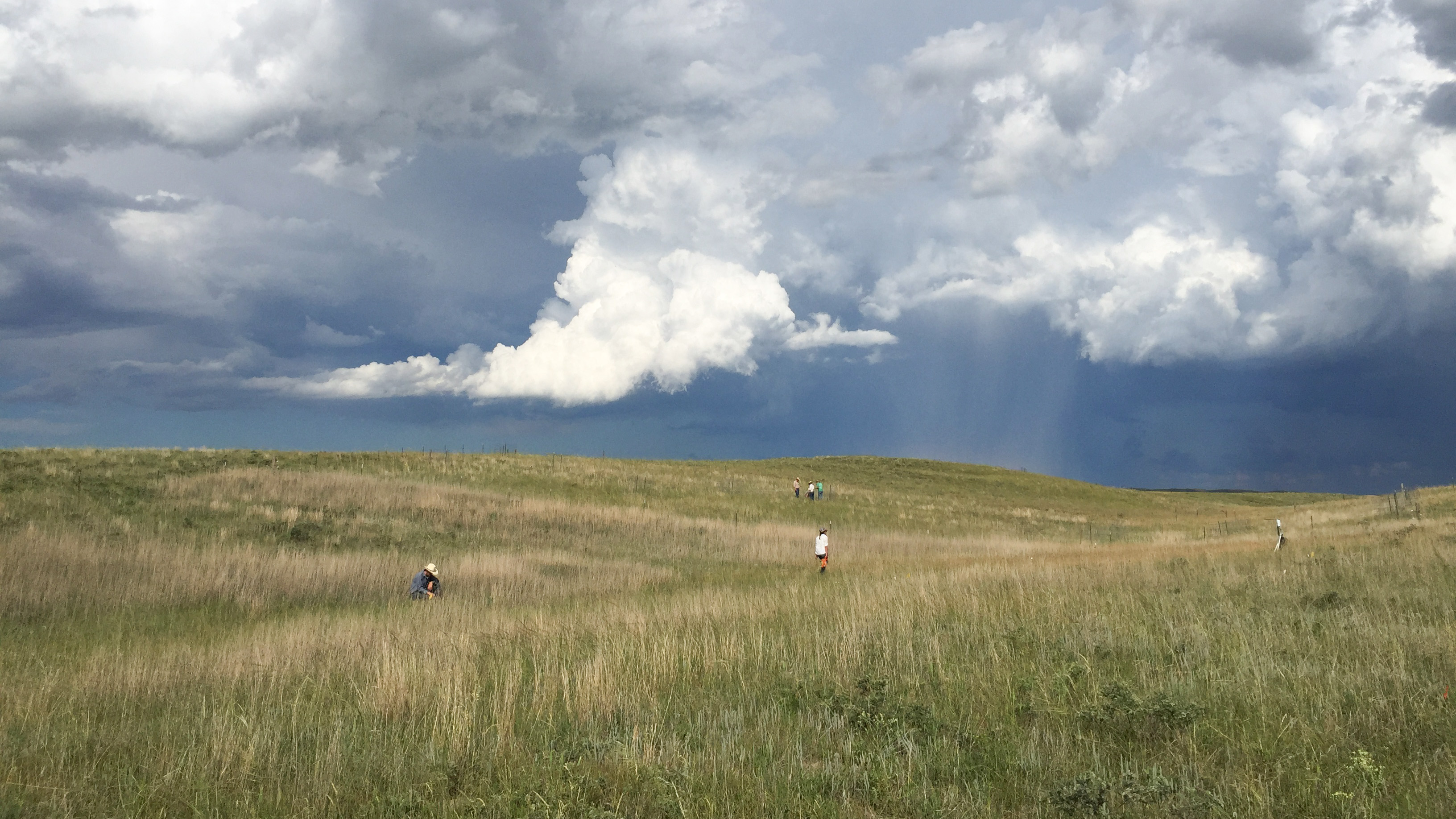Understanding the ecological and economic value of Nebraska’s grasslands is essential for making informed decisions about land use and conservation. By learning how climate, soil, and human activity interact, we can shape a more resilient and sustainable future for Nebraska’s people, prairies, and economy.
Introduction: Why Grassland Conservation Matters in Nebraska
Nebraska occupies a unique position at the heart of the United States, with an expansive landscape and diverse environmental conditions that shape both its ecology and economy. Stretching roughly 450 miles from east to west, the state experiences a continental climate, hot summers, cold winters, and wide variation in precipitation and elevation. Rainfall decreases from about 36 inches annually in the east to 15 inches in the west, while elevations rise from 840 feet to over 5,400 feet. Most of Nebraska’s urban development is concentrated in the east, where rivers and rainfall made early settlement and agriculture more viable.
This range of conditions results in distinct grassland or prairie ecosystems: tallgrass prairies in the east, mixed-grass in the center, and shortgrass prairies in the west. These native grasslands are more than just open spaces—they are complex, dynamic systems that support a remarkable diversity of plant and animal life. From landscaped horticultural plants in city parks to hardy wildflowers and grasses in roadside ditches, Nebraska’s vegetation reflects the state’s environmental gradients of temperature, precipitation, and elevation.
As we explore these prairie ecosystems, we’ll examine how soil types and water availability affect their composition and health. We’ll also look at challenges such as invasive species, habitat loss, and the pressures of modern agriculture, and how prairie restoration, fire and grazing management, and carbon storage can help maintain these landscapes.
Introduction section includes the following files:
- Introduction
- Why Does Grassland Conservation Matter in Nebraska? An Introduction and Overview
Lesson 1: Grassland Ecosystems and Environmental Factors

Students will learn about prairie ecosystems in Nebraska and examine the connections between these ecosystems and the environmental factors influencing their formation and continued persistence.
Essential Questions:
- Understand the importance of grasslands to ecosystems and human life.
- Identify the characteristics of grasslands in Nebraska.
Objective: Students will learn about prairie ecosystems in Nebraska and examine the connections between these ecosystems and the environmental factors influencing their formation and continued persistence.
Lesson 1: Grassland Ecosystems and Environmental Factors includes the following files:
- Lesson Plan: Grassland Ecosystems and Environmental Factors
- GrasslandEcosystems: From Nebraska to Beyond
- Maps of Nebraska Land Use, Precipitation and Vegetation
- Prairie Ecoregion Research Assignment
Lesson 2: Native Nebraska Plants

Students will learn about native Nebraska plants within grassland/prairie ecosystems. They will explore physiological functions and morphological differences, enhancing their ability to identify plants.
Essential Questions:
- What native plants exist in Nebraska?
- How do we classify plants and separate them into different groups?
- Why do plants have different times of growth or physiological functions?
- Why do plants have so many different growth forms or morphological differences?
- How do we identify different plants based on these characteristics?
Objective: Students will learn about native Nebraska plants within grassland/prairie ecosystems. They will explore physiological functions and morphological differences, enhancing their ability to identify plants.
Lesson 2: Native Nebraska Plants includes the following files:
- Lesson Plan: Native Nebraska Plants
- Native Plant Species in Nebraska
- Supplemental Questions
- Plant Growth and Identification Student Notes
- Resin Plant Reference Guides
- Figures
- Progression Cage
Lesson 3: Soils

Students will learn about soil types and their properties. Students will examine where different soil types exist in Nebraska. Students will understand soil layers or horizons. Students will understand soil characteristics or qualities and why they are important.
Key Questions:
What types of soils exist in Nebraska? Why do we have different types of soils? What is a soil horizon? What is a soil profile? What are characteristics of soil that are used to describe a soil profile? What is soil texture? How does texture influence other soil characteristics like water holding capacity and permeability?
Objective:
Students will learn about soil types and their properties. Students will examine where different soil types exist in Nebraska. Students will understand soil layers or horizons. Students will understand soil characteristics or qualities and why they are important.
Lesson 3: Soils includes the following files:
- Lesson Plan: Topic 3 – Soil of Nebraska
- Activity 1: Activity Key
- Activity 2: Soil Horizon Description Sheet Example
- Activity 2: Soil Structure Guide
- Activity 2: Figure: NE Profiles with Horizon Notations
- Activity 3: Soil of Nebraska
- Activity 3: Figures - Soil Texture Triangle Examples
- Activity 3.2: Jar Test Example
- NE Soil Parent Materials Map
- Ribbon and Wire Methods Guides
- Soil Sample Test Tube Rack Assembly
- Soil Texture Triangle Examples
- Test Tube Rack photos folder
Lesson 4: Carbon Cycle Role-Play

Students will recognize that there is a finite amount of carbon in grasslands and on earth. Model how carbon moves around in a grassland environment, from one place to another. Communicate the process and components of carbon flow and sequestration on grasslands. Identify how humans influence the carbon cycle on grasslands. Analyze the importance of carbon sequestration in grassland ecosystems and discuss potential conservation strategies.
Essential Questions:
- How does carbon move through living and non-living parts of an ecosystem, and why is this cycle critical to life on Earth?
- What role do different organisms and environmental processes play in storing or releasing carbon, and how might human actions disrupt this balance?
Objectives:
Students will recognize that there is a finite amount of carbon in grasslands and on earth. Model how carbon moves around in a grassland environment, from one place to another. Communicate the process and components of carbon flow and sequestration on grasslands. Identify how humans influence the carbon cycle on grasslands. Analyze the importance of carbon sequestration in grassland ecosystems and discuss potential conservation strategies.
Lesson 4: Carbon Role-Play Game includes the following files:
- Lesson Plan: Carbon Cycle
- Carbon Cycle Figure
- Carbon Cycle Education Presentation
- Role Playing Cards
- Role-play Summary Table
Lesson 5: Threats to Grasslands •

Recognize the impact of invasive plant species, specifically Canada thistle, on grasslands. Calculate the rate of spread of Canada thistle. Develop critical thinking skills by discussing and proposing solutions to mitigate the effects of invasive species.
Essential Questions:
- How do grasslands contribute to ecological stability and human well-being?
- What makes an invasive species successful in a new environment?
- How can we balance land use (agriculture, urbanization) with conservation?
Objectives:
- Recognize the impact of invasive plant species, specifically Canada thistle, on grasslands.
- Calculate the rate of spread of Canada thistle.
- Develop critical thinking skills by discussing and proposing solutions to mitigate the effects of invasive species.
Lesson 5: Understanding Grasslands includes the following files:
- Lesson Plan: Understanding Grasslands
- Scenarios of Introduction
- Threats to Grasslands Presentation
Additional Publications
Common Forbs and Shrubs of Nebraska: Rangeland, Prairie, and Pasture
by Cheryl D. Dunn, Mitchell B. Stephenson and James Stubbendieck
Common Grasses of Nebraska: Rangeland, Prairie, and Pasture
by Cheryl D. Dunn, Mitchell B. Stephenson and James Stubbendieck
Nebraska Plants Toxic to Lifestock – Including Bloat-Causing Plants: Rangeland, Pastureland, and Cropland
by James Stubbendieck, Michael P. Carlson, Cheryl D. Dunn with Bruce E. Anderson and Daren Redfearn
